Of the Native American Tribes that first lived in Montana were the Crow, known for their enormous horse herds donning elaborate regalia, the Blackfeet, a feared Tribe that made delicious meals from wild cherries and bison meat, and the Kootenai, who called the steep wooded valley of the Kootenai River their home.
Present-day Montana was once a lawless frontier. But before Europeans conquered the Americas, Montana was first home to 11 Native American Tribes that crafted every life necessity from the animals they hunted and the resources they gathered from the land.
Read on for a list of the 12 Native American Tribes that first lived in Montana. Find out what they were known for, their dress, their customs, which part of the state they lived in, and which reservation they live on today.
These are the 11 Native American Tribes that first lived in Montana
Table of Contents:
- Assiniboine
- Blackfeet
- Little Shell Chippewa
- Cree
- Crow
- Gros Ventre
- Kootenai
- Northern Cheyenne
- Pen d’Oreille
- Salish
- Sioux
1. Assiniboine
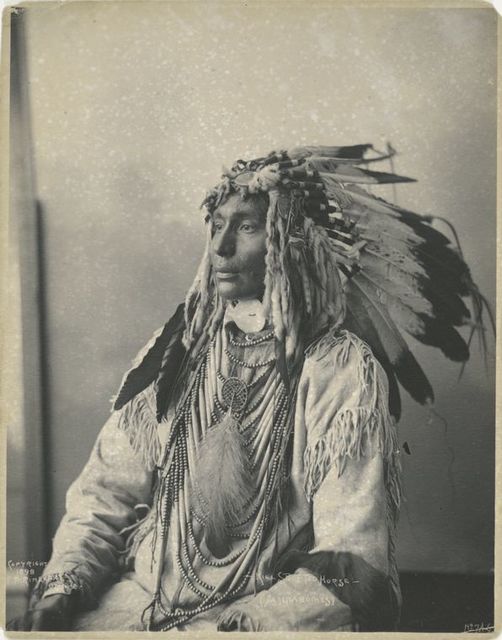
What they were known for
The entire Assiniboine Tribe, including females, were known as excellent bison hunters, horse riders, and fighters.
Like many Native American Tribes that first lived in Montana, they were known for trading pemican (an exquisite dish made from preserved bison meat and wild berries) for firearms delivered by traders on the upper Missouri River.
Dress
Like most Native American Tribes, the Assiniboine wore moccasins as shoes. The women wore deerskin or goat skin dresses.
The men wore leggings and breechcloths (a typical “skirt”-like cloth). Assiniboine crafted and wore beautiful, handmade jewelry.
Customs
The Assiniboine were a mostly nomadic group that lived by the typical plains culture. They were hunter-gatherers who moved their tipi villages as they followed food sources.
Generally speaking, the appearance of their shelters and dress resembles that of the Plains Cree Native American Tribe.
Where they lived in Montana
The Assiniboine were a nomadic Tribe. Therefore, they regularly relocated across the land of present-day Montana.
Current reservation in Montana
Today, the Assiniboine shares the Fort Peck Reservation with the Sioux Tribe and the Fort Belknap Reservation with the Gros Ventre Tribe.
2. Blackfeet
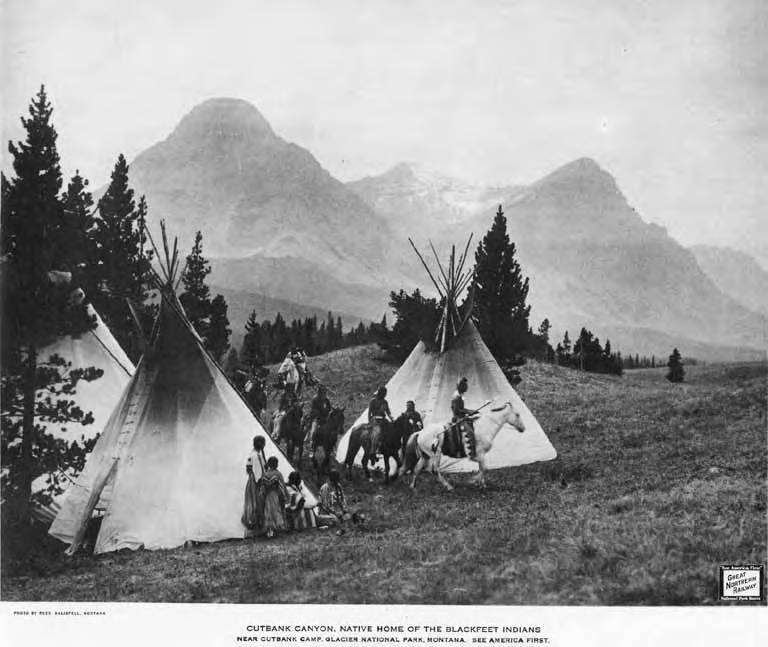
What they were known for
The Blackfeet name carried with it a strong reputation across North America, and they were feared among many Tribes. They were known for being strong and fierce warriors who often battled other Tribes, stealing their horses.
They were one of the toughest Tribes to fight back against the U.S. military forces and prevented many European traders from entering their territories on the upper Missouri until about 1806.
Over time, their territory grew to an exceptionally large area, and by the early 19th century, their sizes were believed to be around 15,000. This immense size composed of highly skilled warriors garnered them a fearsome reputation on the Northern Great Plains.
Dress
The Blackfeet Tribe constructed all of their clothing from bison, antelope, and other plains animals.
They decorated the fringes of their leather clothing with porcupine quills, elk teeth, and other various animal parts, leaving very little to waste.
Typical of most Native American women of the time, Blackfeet women wore long, sleeveless dresses that extended down to their ankles.
Like many Native American Tribes that first lived in Montana, Blackfeet men wore breechcloths and leggings. They also wore tunics, something like a shirt that is knee-length and made from leather, but which is not open down the front. They decorated their tunics with beads.
All tribal members wore moccasins, and in winter, they wore thick bison skins to keep warm. They were also known for painting their faces for special occasions, such as tribal gatherings and war.
Customs
A principal custom of the Blackfeet Tribe was the Sun Dance.
Blackfeet would winter separately in smaller groups, but when summer came, they would gather together for the Sun Dance, a one-and-a-half-day ceremony of sacrifice and renewal consisting of dancing and religious activities. They welcomed the Sun, which they believed healed ill Tribe members.
During the summer months, the Blackfeet also accepted new tribal members.
Where they lived in Montana
The Blackfeet historically occupied the north and northwestern regions of Montana as well as areas of Alberta, Canada.
Current reservation in Montana
The Blackfeet live on the Blackfeet Indian Reservation in northwestern Montana, along the eastern border of Glacier National Park.
3. Little Shell Chippewa (Ojibwe)

What they were known for
The Chippewa, also known as Ojibwe, are a segment of the historical Pembina Band of the Chippewa natives. They were one of the Native American Tribes that first lived in Montana, known for their rich culture that shaped this region for many centuries.
Firstly, the Chippewa were known for their excellent handcrafted birchbark canoes, copper mining, and maple syrup. Because they lacked salt for food preservation, it is believed that they mixed many of their dishes with maple syrup.
They were also skilled farmers, hunters, and fur traders, and organized themselves into different bands, each one named after a different animal. The Chippewa had distinct respect for all living beings on Earth, a tradition born from their belief that they were the last created lifeform on Earth.
Dress
Chippewa clothing was made from tanned deerskins, including moccasins, tunics, breechcloths, and leggings. Women’s long dresses had removable sleeves. Often, the decorations they placed on their clothing signified marital status, hunting skills, or tribal membership.
During cold months, they wore ponchos, high moccasins, leggings, and decorated tunics.
Later on, they adopted some of the European clothing customs, including jackets and blouses, though they adorned them with native beadwork.
Customs
A cornerstone of Chippewa culture is their deeply rooted connection with Mother Earth and their profound respect for all living things. They were hunters, fishers, and gatherers who lived off the land and harvested wild plants for food and medicine.
The Chippewa’s lifestyle is based on living, learning, walking, and speaking truth while developing wisdom and practicing unconditional love and compassion. Their symbols include an eagle, which represents wisdom, and a bear, which represents courage.
Where they lived in Montana
Historically, the Chippewa migrated with the bison across North Dakota and much of Montana. In 1879, the Tribe crossed the Missouri River and created a settlement near present-day Great Falls.
Current reservation in Montana
While the state of Montana officially recognizes the Little Shell Chippewa Tribe, the Tribe does not have an official reservation as it seeks federal recognition from the Bureau of Indian Affairs.
The Chippewa tribal headquarters in Montana is located in Great Falls.
4. Cree
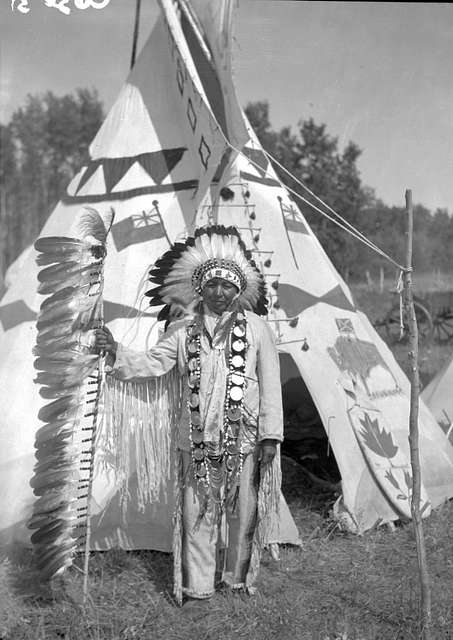
What they were known for
The Cree Tribe is famous for its exquisite beadwork, which female Tribe members used to decorate functional clothing, bags, and furniture.
They were a nomadic Tribe that regularly moved their settlements as they followed the bison herds through the seasons and hunted moose, caribou, and rabbits. They were also distinctly known for painting their tipis.
Dress
Like many of the Native American Tribes that first lived in Montana, the Cree also used animal hides to make their clothing, usually from buffalo, moose, and elk.
The men wore breechcloths, leggings, and long shirts, while women wore long, animal-skin dresses.
During colder months, the Tribe would wear long robes and cloaks made from animal skins for warmth.
Customs
The Cree were known for numerous customs, including the Sun Dance, which was a summer ceremony of renewal and sacrifice, the Thirst Dance (Rain Dance), Powwows, sweat lodges, and feasts.
One of the most interesting traditions in Cree tribal culture was their devotion to animism – the belief in natural spirits with immense power. The Cree believed they could commune with these spirits in their dreams to secure help from them.
Cree valued perseverance, respect, honesty, and kindness, and used storytelling as a way to share knowledge.
Where they lived in Montana
The Cree lived across north-central Montana.
Current reservation in Montana
The Chippewa Cree Reservation is located in north central Montana near the town of Havre. The reservation contains 117,365 acres of land and is home to more than 6,000 enrolled members.
5. Crow
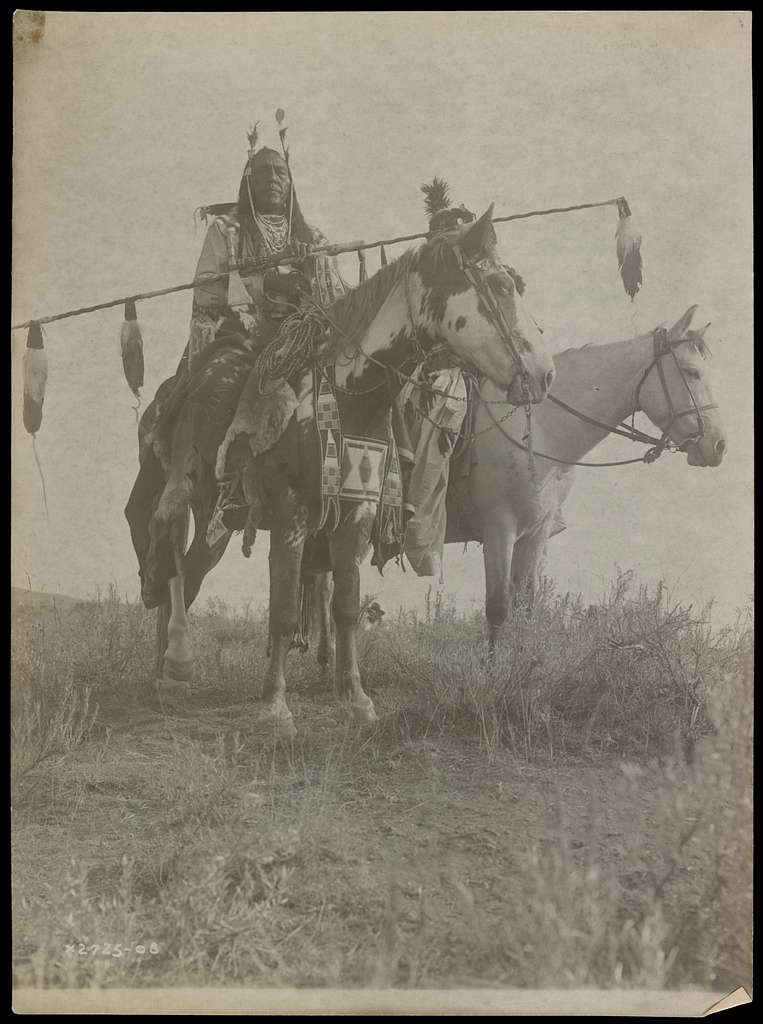
What they were known for
The Crow was a dynamic, powerful, and spiritual native Tribe known for their large horse herds and horse-based ways of travel and hunting.
They were excellent hunters of deer, bison, and elk. Because they were often outnumbered by other Tribes, they rarely started wars. However, they were known for stealing horses from neighboring Tribes, and they had a reputation for adorning their horses with elaborate regalia.
In the Crow language, the name of their Tribe is Apsáalooke, which translates to “Children of the Large-Beaked Bird”. Europeans reduced this to “Crow”, which is what they are known as today.
Dress
The Crow dress was often made from deer or sheep skins. A distinct, decorative piece they applied to their clothing was elk teeth. They were known to adorn a single dress with up to 500 elk teeth.
Colors played a key role in the Crow Tribe’s dress. In their beadwork, they used white, red, yellow, green, and dark blue, all of which had distinct meanings. For example, red represented revenge, and they often chose dark blue instead of black as black symbolized darkness.
Men wore shirts, leggings, robes, and moccasins, while women often wore simple dresses. Unlike the men, women often wore their hair short.
Customs
The Crow Tribe had numerous traditional customs, including the Sun Dance, vision quests, and a tobacco ceremony. They regarded tobacco as a sacred plant.
They followed a monotheistic religion believing the universe consisted of three realms – the physical, the spiritual, and an omnipresent realm that only deities occupied. Furthermore, they believed that spirits took the form of animals, and the Tribe held bison, bears, and birds in high regard.
Where they lived in Montana
After migrating west from the midwestern region of the United States, the Crow Tribe settled in the Yellowstone River valley in southern Montana.
Current reservation in Montana
Today, the Crow Reservation lies in south central Montana where the Big Horn River lies. The reservation borders Wyoming to the south, and its northwestern border comes within 10 miles of Billings.
Learn more: The history of the Crow Indian tribe [CONDENSED]
6. Gros Ventre

What they were known for
The Gros Ventre Tribe originally lived in the Great Lakes region but later migrated west to North Dakota and Montana. As one of the Native American Tribes that first lived in Montana, they were nomadic, hunted bison, and used bison hides for much of their daily needs, including clothing and tipi construction.
They were excellent farmers and hunters. Tribal women harvested corn, beans, and squash and collected berries and fruits while men generally hunted.
The Gros Ventre Tribe originally segmented off from the Arapaho Tribe and, after migrating with the Arapaho, they joined the Blackfeet Tribe.
Dress
The Gros Ventre made clothing from various animal skins, including bison.
Women wore long, buckskin dresses when the weather was cool, and men generally wore breechcloths and leggings. They also were known for their bison hide robes, which they adorned with elaborate quillwork. All tribal members wore moccasins.
Customs
The Gros Ventre had rich spiritual customs.
Their principle ceremony was the Sun Dance, a ceremony of sacrifice and renewal, and their most sacred religious items included various types of pipes, such as the Chief Medicine Pipe and the Feathered Pipe. For example, the Feathered Pipe protected people from illness and could be used to control the weather.
Where they lived in Montana
The Gros Ventre originated from the Great Lakes thousands of years ago and migrated west to various northern U.S. states. They lived across several regions in Montana.
Current reservation in Montana
The Gros Ventre Tribe of Montana shares the Fort Belknap Reservation with the Assiniboine Tribe. The Gros Ventre primarily reside at the southern end of the reservation where the Little Rocky Mountains are located.
7. Kootenai
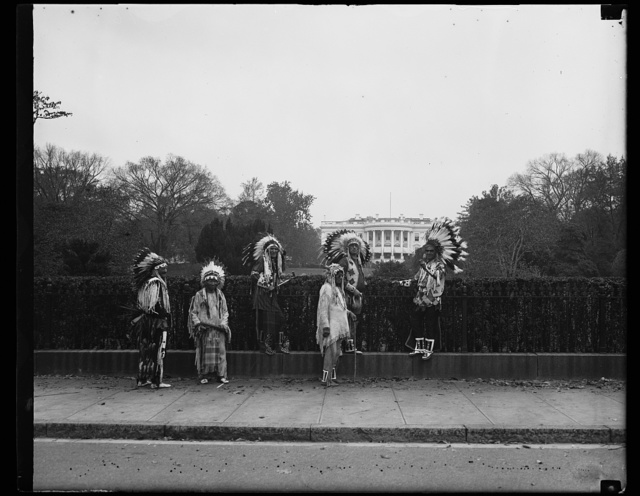
What they were known for
The Kootenai Tribe was a group of relatively peaceful natives that lived along the Kootenai River in northern Montana. They were skilled hunters and gatherers who often traveled by horseback.
In winter, the Kootenai lived in permanent villages characterized by dome-shaped homes constructed from wooden poles and mats.
While the Kootenai Tribe was friendly to traders arriving in the early 1800s, their living conditions slowly worsened as the decades passed, and they eventually ended up with no land.
By 1974, they declared “war” on the United States, a peaceful war that was meant only to be a war with the pen, and their efforts were noticed. They ultimately received 12.5 acres of land to begin rebuilding.
In the Kootenai language, they are called “Ktunaxa”.
Dress
Like most Native American Tribes that first lived in Montana, the Kootenais made clothing from various animal skins, such as antelope, bison, and deer. However, they were also known for making clothing from woven bark and plant fibers.
Men generally wore buckskin shirts and breechcloths, while women wore undecorated frocks.
Customs
Like many other Tribes of this region, the Kootenai’s principle ceremony was the Sun Dance, which for them was focused on hunting success. Another principal figure in their religion was Kootenai Falls, where they went to seek visions and commune with spirits.
Oral legend maintains the Kootenai received the Sun Dance from the Sun Dance spirit, which resided on the far side of the eastern ocean.
They also practiced animism, the belief that spirits embodied all living things in nature, and shamanism, participating in numerous shamanistic ceremonies and rituals.
Where they lived in Montana
The Kootenai Tribe lived in the steep, dense forests of the northwestern region of Montana along the Kootenai River valley.
Current reservation in Montana
Today, most of the Kootenai Tribe in Montana live on the Flathead Reservation in northwestern Montana, which they share with the Pend d’Oreille and Salish Tribes.
The Flathead Reservation consists of about 1.3 million acres, located between rolling valleys and the towering mountain peaks of the Rocky Mountain front.
The Flathead Reservation is also home to the National Bison Range, one of the few remaining places in North America where protected bison roam freely.
8. Northern Cheyenne

What they were known for
The Northern Cheyenne were once part of the Cheyenne Tribe. They were known as hard-working, nomadic people with a profound knowledge and appreciation for the Earth, its land, and the living creatures on it, and relied on bison for much of their needs, including food, shelter, and clothing.
They were known to be skilled and feared mounted warriors.
Dress
The Northern Cheyenne made all of their clothing from the animals they hunted. During warmer months, they wore clothing from deerskin, while during the winter months, they donned robes made from bison hides.
Men generally wore breechcloths and leather leggings, while women wore long dresses. Much of their clothing was decorated with elk teeth and porcupine quills, and warrior shirts and women’s dresses were often fringed.
The Northern Cheyenne wore distinct moccasins that covered their entire foot, were secured around the ankle, and had a block pattern around the top.
Customs
As with most native American Tribes of this region, the Sun Dance was also a principal aspect of the Northern Cheyenne’s spiritual customs. They performed an elaborate Sun Dance ceremony of renewal each year in which the men adorned themselves with body paint and fasted for four days.
They believed a guardian spirit bestowed special powers upon them as they danced.
The Northern Cheyenne’s three other primary religious ceremonies included the renewal of Mahuts, the Massaum (Animal Dance), and the Isiwun.
Generally speaking, they were animists, believing that everything, including people, animals, rocks, and minerals, was united by one spirit. Their two primary deities were the Maheo (Wise One Above) and the spirit of the earth.
Where they lived in Montana
The Northern Cheyenne migrated west from the Great Lakes region and lived in various places throughout present-day Montana.
Current reservation in Montana
The Northern Cheyenne reservation is located in the high plains of southeastern Montana on the beautiful Tongue River, just east of the Crow Reservation.
Learn more: History of the Northern Cheyenne Tribe [CONDENSED]
9. Pend d’Oreille
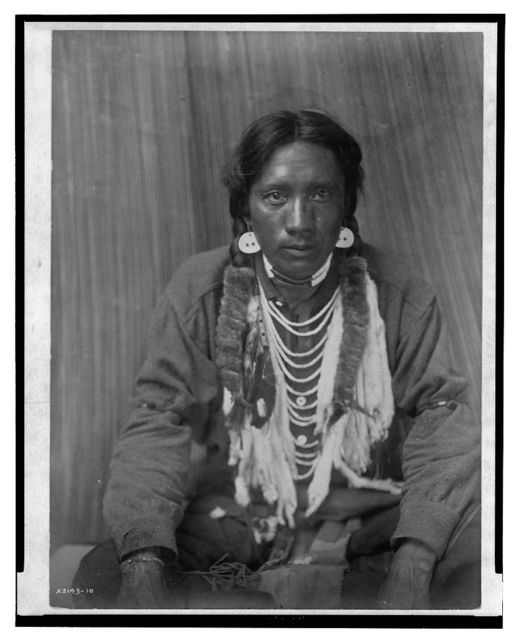
What they were known for
The Pend d’Oreille Tribe, also known as the Kalispel, lived in relatively typical tipis in the summer, but they lived in unique lodges in the winter. The Tribe wove cattails into tule mats and attached them to tree branches to form a hut.
The Pend d’Oreille regularly traded bison hides for horses and other goods, and they were known for creating weapons from flint and forging many other daily necessities from rock.
The Tribe received its name “Pend d’Oreille” from French traders, which means “hangs from ears” in French, referring to the large shell earrings the Tribe members often wore.
Dress
The Pend d’Oreille Tribe was known for making clothing from rabbit pelts and deer hides, and for decorating their hides with beads, quills, dyes, and paints.
Customs
The Pend d’Oreille Tribe were hunter-gatherers who followed similar customs as the Salish. They gathered various roots from spring through the summer growing season, including camas bulbs, bitterroot, onions, carrots, and potatoes.
The camas root was a staple in their diet, which they baked and dried for long-term storage.
Where they lived in Montana
The Pend d’Oreille’s territory once covered 20 million acres of land from the Cascade Range to the Rocky Mountains, through northern Idaho, and across southern Canada to western Montana.
Discover the complete history of the Pend d’Oreille Tribe in my other article, History of the Pend d’Oreille Tribe [CONDENSED].
Current reservation in Montana
Today, most of the Pend d’Oreille Tribe reside on the Flathead Reservation on the Flathead River in northwestern Montana. They share the Flathead Reservation with the Bitterroot Salish and Kootenai Tribes.
10. Bitterroot Salish
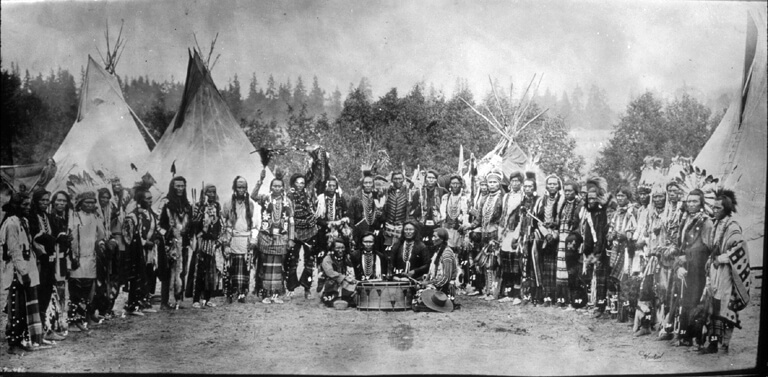
What they were known for
The Bitterroot Salish Tribe was a fascinating group that lived off the land, using an ancient network of trails and paths to gather resources for the coming year.
They were well-known for building totem poles that symbolized a Tribe member’s spirit animal or their family crest. Today, some Tribe members continue this tradition by building and selling totem poles forged in the traditional ways.
Discover the complete history of the Bitterroot Salish tribe in our article, History of the Bitterroot Salish Tribe [CONDENSED].
Dress
Like many of the Native American Tribes that first lived in Montana, the Bitterroot Salish generally wore dressed skins. For men, this meant breechcloths, and for women, tunics. All Tribe members wore leggings and moccasins.
On formal occasions and during colder months, the men would wear a bear-skin cloak over their shoulders. Women were known for wearing beautiful jewelry, such as necklaces made from beaver teeth or bear claws, which symbolized their wealth.
Dancers at traditional ceremonies often wore animal skin masks.
Customs
The Bitterroot Salish mostly lived divided into numerous autonomous bands consisting of related families, each with its own territory and chief.
During winter months, they stayed in one place, usually in a village along a river. In summer, they would travel a network of ancient trails and paths gathering resources for the entire upcoming year, foraging for wild plant foods, and hunting.
Guardian spirits played a principal role in Bitterroot Salish spirituality, and the Tribe believed in shape-shifting, or the transformation between animal and human spirits.
Where they lived in Montana
Historically, the Bitterroot Salish occupied a region of Montana just west of Billings, which stretched just below present-day Great Falls to the Rocky Mountains and extended south to the Wyoming border.
Throughout the summer months, the Bitterroot Salish Tribe migrated throughout western Montana to gather and hunt for food. Eventually, they permanently settled in the Bitterroot Valley.
Current reservation in Montana
The majority of the Bitterroot Salish Tribe lives on the Flathead Reservation in northwestern Montana. They share the Flathead Reservation with the Kootenai and Pend d’Oreille Tribes.
11. Sioux

What they were known for
The Sioux were a much-feared, valiant warrior Tribe. They dominated the Great Plains for centuries and warred with the U.S. Army. They were honored among Tribe members for their courage and strength.
They were also fine craftsmen and artisans, known for intricate beadwork, pipemaking, flute making, and leatherwork.
Dress
Sioux women generally wore long deerskin or elk skin dresses which were fringed or decorated with quills, rabbit fur, beads, or horsehair. Sioux men wore breechcloths, leggings, and buckskin shirts.
All Tribe members wore moccasins, and during colder months, they wore bison-hide robes and leggings.
When decorating their clothing, they used several color pairs together, including green and yellow, blue and green with rose, and rose and yellow.
The Sioux were also well-known for wearing elaborate headgear.
Customs
The Sioux participated in various ceremonies, including name-giving, sweat lodge, healing, marriage, and the Sun Dance, which was their most sacred ceremony.
The Sioux also practiced powwows as mourning ceremonies, to commemorate family, or to serve various other purposes. These powwows involved much singing, drumming, and feasting and could last for several days.
The Ojibwe, who were the Sioux’s longtime enemy, once gave the Sioux the nickname “Nadowessioux”, which means “little snakes”. Eventually, fur traders adopted and abbreviated this nickname to Sioux, which stuck.
Where they lived in Montana
The Sioux Tribe called much of the Great Plains home, settling across various regions of Montana.
Current reservation in Montana
Today, the Sioux Tribe shares the Fort Peck Indian Reservation in northeast Montana with the Assiniboine Tribe. The Fort Peck Reservation spans across four counties and is the 9th largest reservation in the U.S.

